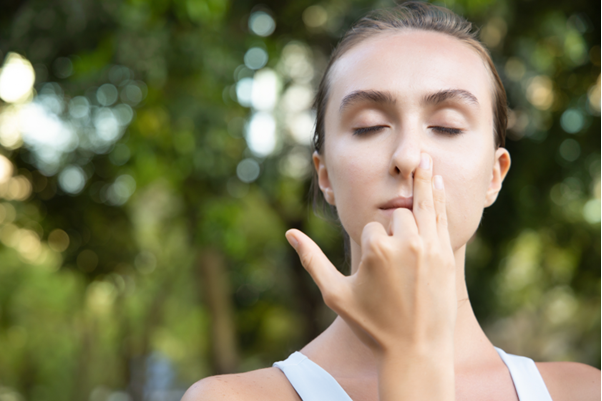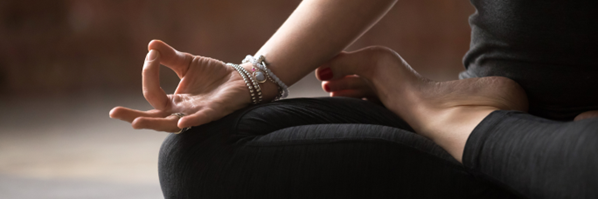
A Guide to Pranayama Breathing Techniques
January 10, 2024
Are you breathing easily? It’s not a trick question. In a time when most of us spend our days racing from one commitment to the next, constantly running behind schedule, it can be hard to catch a proverbial breath. As a result, our stress levels remain almost permanently high, and many of us can’t shake the feeling of constantly running behind or not doing enough.

Practicing yoga is an excellent way to tune into your breath and connect your body and your mind. Adding pranayama to your yoga practice will enhance these benefits even further. In this blog, we’re exploring the practice of pranayama and show you how to integrate it into your day-to-day routine.
What is Pranayama?
The term pranayama comes from two Sanskrit words, ‘prana’ and ‘ayama.’ Prana describes the life force energy that is thought to separate the living from the dead. Ayama means to control or regulate. Put together, pranayama refers to yogic breathing exercises. You may also have come across the word ‘breathwork’ in this context.
Pranayama or breathwork is about more than controlling your breathing. These exercises really aim to increase your life force or energy with the help of your breath. All types of pranayama follow a unique pattern with three components: inhalation, retention of your breath, and exhalation.
What Are the Benefits of Pranayama?
Increasing your energy or your life force may seem like enough of a benefit to start practicing pranayama now, but it’s also something that’s difficult to measure. Pranayama has other benefits that are equally valuable.
These benefits include:
- Calming the mind, reducing stress and worries – this is where breathwork complements both yoga and meditation
- Boosting the immune system and improving lung function
- Improving attention span and focus, and removing brain fog
- Increasing creativity
- Normalizing blood pressure

Pranayama is a powerful practice with the potential to influence your physical and mental well-being. Understanding the strengths of the individual types of breathwork allows you to choose the most suitable practice for different circumstances.
What are the Different Types of Pranayama?
Think of different types of pranayama as a toolbox from which you can choose the most appropriate tool for a specific purpose. Granted, using pranayama in this way requires a bit of practice, but setting aside a few minutes every day or even a few times every week will let you go far.
Here is a closer look at five of the most popular types of pranayama:
Yogic or Diaphragmatic Breathing
Let’s start with the main yogic breath, which is also known as diaphragmatic breathing. This breath is the foundation of all breathwork. As the name suggests, this type of pranayama teaches you to use only your diaphragm to breathe rather than your chest or intercostal muscles.
Your belly will still move, but this movement is initiated by the diaphragm rather than the stomach muscles. You can start practicing this technique by sitting in a comfortable position with one hand on your belly and the other on your chest. As you breathe in and out, only your stomach should be moving.
Ujjayi or Ocean Sound Breathing
Pranayama practitioners also know ujjayi breathing as the hissing breath, ocean-sound breath, and even victorious breath. Practicing this type of breath creates heat and vitality as well as increases focus and concentration. Ancient texts suggest that ujjayi breathing helped yogis overcome illness and even death.
You start by sitting comfortably and breathing through your mouth using yogic breathing. Now add an ‘h’ sound and feel the constriction in your throat. Keep this contraction while closing your mouth. Without straining your neck, try to create a soothing and pleasing sound and notice any changes.
Bhramari or Buzzing Bee Breathing
Bhramari breathing is an excellent tool to help soothe your nerves and calm an overactive mind. You start by inhaling slowly and deeply through both nostrils. As you exhale, try to constrict your throat slightly to make an ‘eee’ sound, like the buzzing of a bee.
Repeat this pattern for five to ten rounds and try to make your buzzing noise louder without straining your neck. When you’re first starting to practice pranayama, you may need to restart a few times. Don’t be discouraged and keep practicing. The benefits make it worthwhile.
Nadi Sodhana or Alternate Nostril Breathing
This type of pranayama is a great way of helping you balance your energy, calm down, and deal with anxiety. As usual, you start by sitting in a comfortable position and breathing normally. Now, close your right nostril with your thumb. Breathe in from the left nostril. Then close your left nostril with your ring finger and exhale through your right nostril. Inhale again on the right, then close your right nostril, move back to your left, and exhale. Inhale again on the left and continue like that for several minutes.
Sama Vritti or Box Breathing
This breathing exercise aims to balance the energy flowing through your body and helps to minimize mental chatter, stress, or worry. Your goal is to equalize the length of your inhalation, breath retention, and exhalation. One of the simplest ways to start practicing sama vritti breathing is to count to three or four when you inhale, use the same count when you retain your breath, then again when you exhale, and when you hold the exhalation. This is not a technique to practice or extend your breath-hold skills, so you should choose a count that feels easy and comfortable.
How Can I Start Practicing Pranayama?
All five breathing exercises above are accessible to beginners, and they’re an excellent way to start exploring breathwork. However, starting any new practice on your own can be daunting. If you prefer to have the guidance of an experienced instructor, don’t hesitate to join one of our regular Uptown Yoga classes. We regularly include pranayama in our classes, and our instructors are always happy to introduce specific exercises if you let them know.
Pranayama is powerful. If you feel you’re ready to work on advanced breathing techniques, it’s worth considering private breathwork classes to make sure your practice is tailored to you. Do you want to know more about pranayama? Get in touch today.




